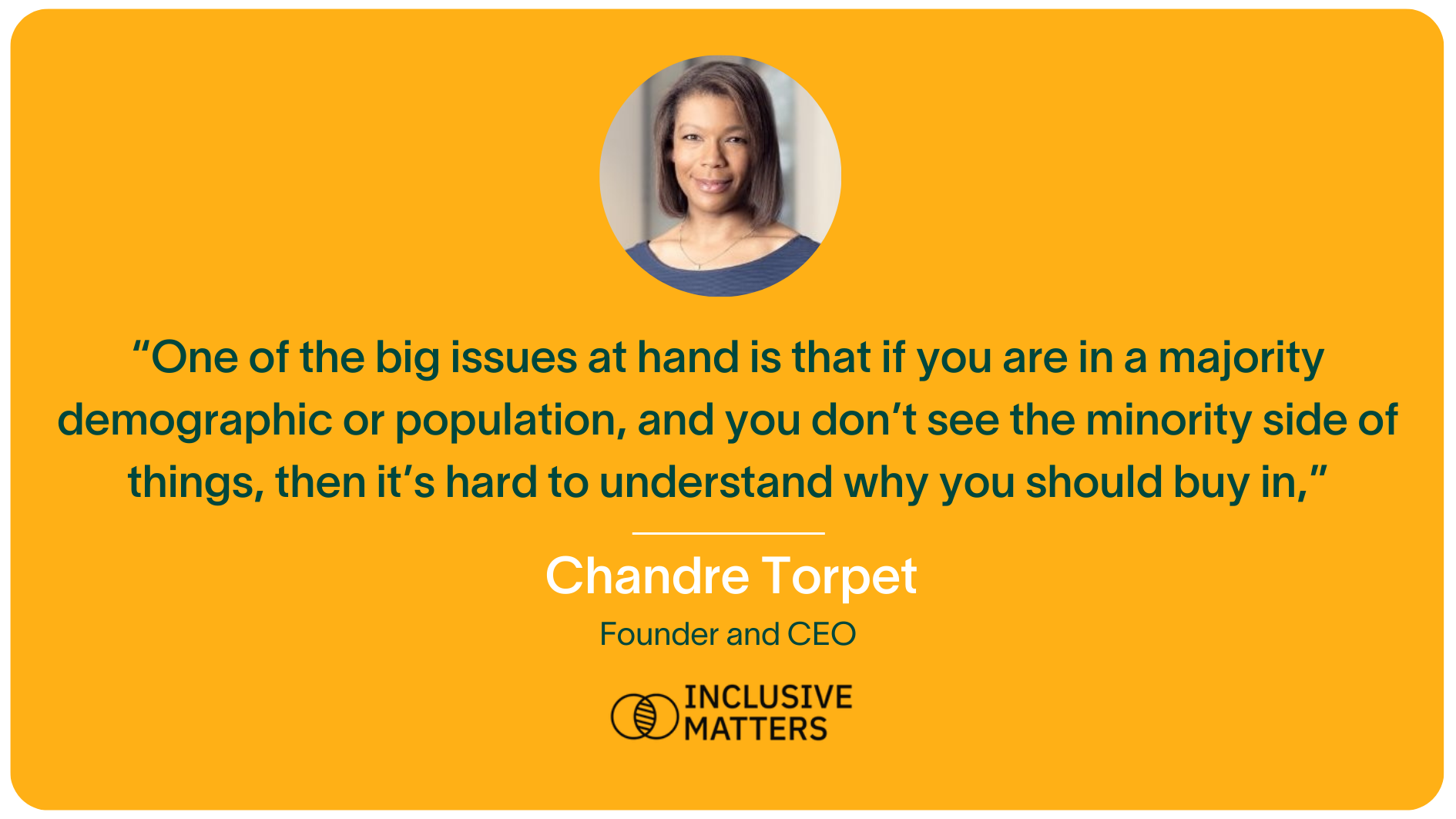Leaders are critical to setting the drumbeat for any organisation. They rally the workforce around a shared sense of purpose, and make sure everyone pulls in the same direction to achieve key business goals. They set the tone for the right behaviours that define high-performance.
That makes them especially critical for the success of your DEI initiatives. So how do you get leaders to buy-in on your diversity and inclusion strategy, and make it a priority?
In this article, Chandre Torpet, founder and CEO of DEI consulting firm Inclusive Matters, explains why it’s hard to get leadership buy-in, and outlines some strategies to make it happen.
The challenge of getting leadership buy-in for DEI
Getting leadership buy-in is essential to the success of your DEI strategy. But it’s not always easy to get senior leaders to understand how DEI is a priority to the business.
So why is this happening?
“One of the big issues at hand is that if you are in a majority demographic or population, and you don’t see the minority side of things, then it’s hard to understand why you should buy in,” Chandre says. “A lot of leaders are more focused on the major factors that go with running a business — they’re looking at the bigger picture and the economics side of things.
“Let’s use a parallel and say we’re talking about AI, for example,” Chandre adds. “When your company first starts talking about implementing AI, that discussion is probably going to start with someone in your IT department. Nobody has the foundational knowledge of how to make it work yet. But as the conversation evolves, you’re going to develop more expertise in how it impacts the rest of the business, and it will become a bigger priority.
“Like AI, DEI is still a new concept to many senior leaders. They don’t feel they have the expertise to move it forward. There’s still a focus on representation numbers, rather than root causes of why things are happening. There’s a shift in mindset that needs to happen before companies can move faster on their DEI goals.”
How to get senior leaders onboard with your DEI efforts
By this point, most organisations know that there’s a strong business case for diversity, equity, and inclusion. They know, for example, that diverse and inclusive companies experience better profitability, financial performance, and innovation.
But the thing that many still struggle with is unlocking these benefits within the context of their own organisation.
1. Reframe how people see DEI with hard metrics.
“Businesses often approach DEI efforts from the softer side of ‘doing good’,” Chandre says. “It’s seen as this soft, fluffy, gentle effort that’s focused more on how we treat each other, not because it’s for the good of the business. But for leaders to make it a priority, they need to understand that it’s essential for their business to grow.”
The trouble is, most leaders understand that DEI is good for the business. But very few understand how.
“We need data to frame that new perspective to help organisations connect the wider impact of their experience as a business,” Chandre says. “You need to be able to connect it to core business goals — like are you able to expand your sales in new market spaces? What is your engagement like on social media? How can you expand or innovate your product? Now, how do you link those goals back to the human element? That’s how you bridge the disconnect in understanding.”
2. Connect the right data to the right decision-makers across your organisation.
“There are two key issues here when getting leaders to prioritise DEI,” Chandre says. “Number one, organisations are at a saturation point when it comes to their DEI data. There’s so much of it, it’s hard to know where to look. Number two, the data we’re looking at is usually laser-focused on one area of the business: HR. That means we’re not seeing the data that could have an impact on the wider business from external sources.”
When DEI data is purely focused on its impact on people, it’s harder to see how it correlates to the rest of the business. And that’s part of the problem, says Chandre.
“The best way to get leaders across your business to prioritise DEI is by connecting the right data to the right decision-makers,” she says. “That’s how you build alignment for your efforts across senior and department leaders.”
Distilling this down to department-level goals can help build alignment across department leads and managers. For example, linking DEI to your customer service team’s core KPIs in a retail context might involve how DEI impacts your customer engagement and loyalty. Linking DEI concretely to CSR goals might involve diversifying your suppliers.
3. Bring in agile teams to solve problems.
DEI is a collective effort across your whole organisation — it won’t work in a silo. This means that in order for everyone — including your leaders — to buy in and create alignment on why it’s important, you need to take an agile approach to collaboration.
“One of the most effective examples I’ve seen that helps build leadership buy-in revolves around implementing agile ways of working,” Chandre says. “To solve a problem, an organisation might bring in agile teams — people from all different parts of the company — to get some new perspectives and approaches.
“This not only helps drive better alignment across the business, but means that people come together, cross-functionally, to work on a key challenge. With DEI, this could be very impactful to help organisations focus a collective effort on solving some of the biggest DEI-related challenges for the business — but it also means it cascades throughout the rest of the company.”
___
Develop Diverse is an inclusive communication platform that helps organisations make inclusive switches in their written texts. Trusted by Maersk Tankers, Vestas, and Danske Bank, our research-based platform combines the best of science with technology to help organisations eliminate bias, communicate more inclusively, and build a more diverse, inclusive organisation. Find out more by booking a demo.





